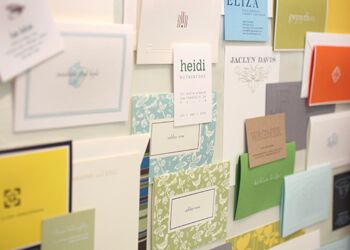Pushing the envelope | Printer and stationery company William Arthur keeps pace with digital times
While the writing was on the wall for many paper products firms attempting to survive in the digital age, employees of a stationery company in West Kennebunk were busy discussing honeysuckle, Pantone’s color pick for 2011. On the company blog, they posted about Rudyard Kipling’s ink-stained desk, and likened a new book by Stacy Schiff, “Cleopatra,” to the papyrus stem used by ancient Egyptians.
William Arthur Inc.’s blog makes it abundantly clear: These people know paper. A market leader in fine stationery, the company’s blog, www.williamarthurblog.com, also tells the story of how the paper company recovered from layoffs in 2009 to thrive in an electronic world.
“Our digital strategy has helped to provide growth again to the business after the negative impact of the economic downturn in 2008 and 2009,” says Sean Tabb, vice president of marketing and new product development at William Arthur.
Within a year, the paper supplier bounced back with a social media strategy and invested $1 million in new powerhouse digital equipment and a handful of employees. Production and work flow in the manufacturing plant on Alewive Park Road sped up, distribution increased and access to customers grew. The business leveraged its capital and e-commerce to strengthen sales and profitability. Now, William Arthur is preparing to roll out a new line in October.
The 60-year-old company is an autonomous subsidiary of the privately owned greeting card giant Hallmark. The bulk of its business is high-end invitations, mostly for weddings, as well as stationery and holiday cards. The company uses methods including engraving, thermography, letter press, flat printing and now digital flat printing.
“William Arthur has been almost in a class by themselves,” says Patti Stracher, manager of the National Stationery Show. “They are considered one of the most prominent, luxury invitations companies in the world. They are leaders in design, innovators, incredible service providers and fierce competitors who have the resources to put a plan into action quickly.”
With the exception of website sales, the manufacturer supplies four paper lines, including the new one launching in October, to an estimated 1,750 retailers throughout the country — 26 in Maine and New Hampshire alone. Among them are The Paper Patch and Papier Gourmet in Portland and the Village Paperie in Kennebunk. William Arthur’s staff numbers about 280, including seven new positions associated with digital printing and approximately 40 people who work from home lining envelopes, tying ribbons and mounting layers on stationery. William Arthur’s signature brand offers personalized and boxed stationery products for all occasions: wedding, baby, holiday, moving, social stationery and sympathy cards. The company also offers Rita Renning Wedding and Stationery Collection for brides and a third line of invitations, Vera Wang Fine Papers, which captures the high-fashion and sophistication of the designer’s wedding dresses. The newest line, Essentials, capitalizes on the company’s enhanced digital potential with new products.
William Arthur was ahead of the industry trends in 2005 when the collaboration with Vera Wang began, according to Stracher, who hosted William Arthur and thousands of other personalized communication companies in May at the National Stationery Show in New York City. Apparently, stationery is hip again and paper has become a fashion accessory.
“Fashion designers are getting into the paper industry: Lilly Pulitzer, Kate Spade and Vera Wang,” says Stracher. “Design elements of all the synergistic industries from fashion to architecture to home decor are all being used by stationery companies now.”
Tough times for print
Like their print companions newspapers and books, stationery and greeting card companies experienced a drop in sales in 2008 as consumers used more digital products offered through the Internet.
“In past recessionary times, generally speaking, personal communications were not affected adversely, beyond a little bump. People may skip the gift, but they still send cards to stay connected in a personal way,” says Stracher. “In the digital age, that changed. Now, more cards are also being sent various ways online.”
The U.S. Postal Service experienced a 29% decline in first-class mail volume between 1998 and 2008, due to the growing use of e-mail and web correspondence, coupled with a rising cost of postage. A proliferation of e-cards and informal greetings through online platforms like Facebook contributed to the struggle. While small stationery and greeting card retailers bore the brunt of the shift to online communication, suppliers did not go unaffected.
William Arthur, which had just seen revenue peak in 2007, watched as sales for the company fell. (As a subsidiary of Hallmark, the company is prohibited from revealing revenue figures.)
“The economic downturn that started in the fall of 2008 negatively impacted the company’s growth,” says Paul Wainman, president of William Arthur. “We experienced reduced sales and profits in 2008 and 2009, which resulted in a reduction in force of 46 people in 2009.”
Meanwhile, photo-sharing websites like Snapfish and Shutterfly began allowing consumers to upload digital photos. Although William Arthur’s profits are driven by the wedding industry most of the year, during the winter holiday season sales are dominated by the photo card.
“The balance tipped in 2008 to digital in cameras,” says Tabb. “We started hearing that consumers wanted to apply digital photos onto their holiday cards.”
That prompted William Arthur’s foray into its digital strategy. In 2008, it augmented its inventory of stock photo cards with peel-and-stick borders for consumers to place their own photos with digital photo cards. The demand for the digital photo card not only led William Arthur to invest in digital equipment, it also convinced the company to ramp up its website to give customers the option to upload their photos online.
The company took this opportunity, with other major stationery suppliers like Crane & Co., to give its website a facelift and a competitive edge over retailers. The investment also allowed customers to shop online.
By spring 2010, William Arthur launched its blog, followed by presences on Facebook, Twitter and Shutterfly. Today, the blog posts new content twice a week and pulls in over 5,000 visitors a month, with traffic still growing at a monthly rate of 5% to 10%. One feature called “As Seen In” links to sites and magazine spreads featuring William Arthur products. Another section of the site in development will allow customers to design and proof their own invitations, a process that can take hours in a store.
“The more followers we have online, the more people are aware of what we’re doing,” says Tabb.
“We are more engaged — we have more brides and we have conversations with our customers we didn’t have before,” adds Wainman.
To make way for digital photo cards, William Arthur invested $1 million in equipment, including an HP Indigo digital press, a large format digital printer, Konica Minolta digital presses and digital workflow equipment and software that improved process efficiency by as much as 10% in some cases inside the company’s 100,000-square-foot manufacturing facility.
The paper company created seven new digital positions, including four digital press operators, an e-commerce manager, a web support specialist and a digital workflow press specialist to bring their digital strategy to life.
Since the 2010 holiday season, Wainman says the company has experienced steady growth. Additonally, the sales and revenue decline of that year have leveled off, due in part to a 55% increase in the company’s digital business.
“The presses and printers have enabled us to create new digital photo cards, invitations and announcements for many different product categories, including holiday, wedding and baby,” says Tabb.
Other stationery companies followed suit, says Stracher.
“The digital photo helped holiday card sales,” she says. “By 2010 the stationery industry had picked up again, and photo cards were a huge part of the market. Paper started to be sexy again.”
A rather unexpected addition to William Arthur’s digital strategy pushed the envelope of traditional paper. The company realized the digital equipment purchased to create holiday cards could do more things the traditional analog machines couldn’t. The company’s Essentials line of digital products, launching this fall, features four new collections of accessories for weddings, bar and bat mitzvahs and other special events.
“The new line will include personalized items including favor boxes, napkins, wall decals, and something called witness posters, which guests are asked to sign, similar to a guest book,” says Tabb. “There are a number of materials that can be used in our digital printer that we’ve only begun to explore.”
William Arthur Inc.
7 Alewive Park Road, West Kennebunk
Founded: 1949
President: Paul Wainman
Services: Luxury stationery, including wedding invitations, baby announcements, personalized stationery, holiday greeting cards and holiday photo cards
Employees: 280
Contact: 1-866-985-3472
www.williamarthur.com
Anna Fiorentino, a writer based in Kennebunkport, can be reached at editorial@mainebiz.biz.
Read more












Comments